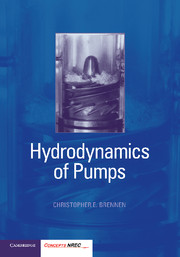Book contents
- Frontmatter
- Contents
- Preface
- Nomenclature
- 1 Introduction
- 2 Basic Principles
- 3 Two-Dimensional Performance Analysis
- 4 Other Flow Features
- 5 Cavitation Parameters and Inception
- 6 Bubble Dynamics, Damage and Noise
- 7 Cavitation and Pump Performance
- 8 Pump Vibration
- 9 Unsteady Flow in Hydraulic Systems
- 10 Radial and Rotordynamic Forces
- Bibliography
- Index
6 - Bubble Dynamics, Damage and Noise
Published online by Cambridge University Press: 04 February 2011
- Frontmatter
- Contents
- Preface
- Nomenclature
- 1 Introduction
- 2 Basic Principles
- 3 Two-Dimensional Performance Analysis
- 4 Other Flow Features
- 5 Cavitation Parameters and Inception
- 6 Bubble Dynamics, Damage and Noise
- 7 Cavitation and Pump Performance
- 8 Pump Vibration
- 9 Unsteady Flow in Hydraulic Systems
- 10 Radial and Rotordynamic Forces
- Bibliography
- Index
Summary
Introduction
We now turn to the characteristics of cavitation for σ < σi. To place the material in context, we begin with a discussion of bubble dynamics, so that reference can be made to some of the classic results of that analysis. This leads into a discussion of two of the deleterious effects that occur as soon as there is any cavitation, namely cavitation damage and cavitation noise. In the next chapter, we address another deleterious consequence of cavitation, namely its effect upon hydraulic performance.
Cavitation Bubble Dynamics
Two fundamental models for cavitation have been extensively used in the literature. One of these is the spherical bubble model which is most relevant to those forms of bubble cavitation in which nuclei grow to visible, macroscopic size when they encounter a region of low pressure, and collapse when they are convected into a region of higher pressure. For present purposes, we give only the briefest outline of these methods, while referring the reader to the extensive literature for more detail (see, for example, Knapp, Daily, and Hammitt 1970, Plesset and Prosperetti 1977, Brennen 1994). The second fundamental methodology is that of free streamline theory, which is most pertinent to flows consisting of attached cavities or vapor-filled wakes; a brief review of this methodology is given in chapter 7.
Virtually all of the spherical bubble models are based on some version of the Rayleigh-Plesset equation (Plesset and Prosperetti 1977) that defines the relation between the radius of a spherical bubble, R(t), and the pressure, p(t), far from the bubble.
Information
- Type
- Chapter
- Information
- Hydrodynamics of Pumps , pp. 78 - 95Publisher: Cambridge University PressPrint publication year: 2011
